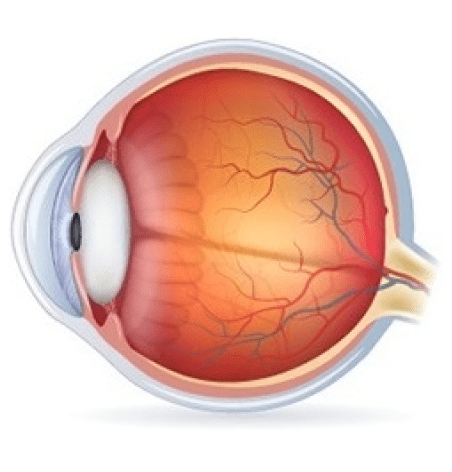20 years of experience in implementing innovations
Since 2004, the SAIF-OPTIMA clinic has been successfully treating eye diseases for adults and children. And for 20 years, the main tenet of our activity has been the struggle for quality in the diagnosis and treatment of patients, rather than increasing their number.
In 2010, for the first time in Uzbekistan, we introduced the method of corneal collagen crosslinking for the treatment of keratoconus. To date, the clinic has conducted more than 3,000 procedures.
Since 2011, the clinic has been implanting intrastromal segments for the treatment of keratoconus, and since 2016 this procedure has been performed accompanied by a femtosecond laser.
What is keratoconus?
Keratoconus is a non–inflammatory eye disease that leads to thinning and a gradual change in the normal shape of the cornea from spherical to conical.
Because of this, the light rays begin to refract unevenly, which leads to loss of visual acuity and visual distortion of objects.
Untimely treatment can lead to almost complete loss of vision.

Healthy eye

Keratoconus
How is it manifested?
The first manifestations of keratoconus, as a rule, occur in adolescence (10-16 years old). However, there are cases of late development of keratoconus at the age of 25-30 years.
The course of the disease is usually characterized by slow progression over 10-15 years. The patient begins to experience a decrease in visual acuity and bifurcation of objects.
How to treat?
To date, for the treatment of keratoconus, specialists of our clinic use internationally recognized techniques such as corneal collagen crosslinking and corneal segment implantation.
Crosslinking
The only method that can stop the progression of the disease at the initial stage is corneal collagen crosslinking (CXL).
Crosslinking is a procedure that strengthens the connective tissue of the cornea. For this purpose, UV radiation and the photosensitizer riboflavin are used. Under their influence, the molecular bonds of corneal collagen are strengthened, contributing to the improvement of the biomechanical properties of the cornea.
We were the first in Uzbekistan to provide a crosslinking procedure for the treatment of keratoconus. Over 10 years, more than 3,000 procedures have been performed, and the accumulated experience has shown the effectiveness and safety of the method.
Implantation of corneal segments
Corneal segment implantation is a modern keratoconus treatment technique aimed at strengthening the cornea, giving it a more correct shape and restoring visual functions.
This is a corrective method that serves as an alternative to scleral and rigid contact lenses, which minimizes the patient’s discomfort from the effects of the disease.
The main task of the segments is to make the zone, which has the shape of a cone in keratoconus, flatter, and bring its shape closer to the optimal spherical one.
Quite often, segments are used as part of the complex treatment of keratoconus in combination with crosslinking — in this case, it is possible not only to increase visual acuity, but also to slow down the progression of the disease itself.
Advantages of keratoconus treatment at the SAIF-OPTIMA clinic
High-quality diagnostics
Our patients undergo a complete and high-quality examination using the high-end equipment. We have unique devices for this:
- OCT of the anterior segment on the CASIA2 tomograph (Tomey, Japan) to determine the cornea parameters and the anterior chamber angle.
- EM-4000 Tomey endothelial microscope for counting endothelial cells that ensure corneal transparency, their condition is very important to assess before planning surgery.
- Topolyzer Vario WAVELIGHT and ATLAS Zeiss keratotopographs ensure the accuracy in examination of patients with high levels of corneal irregularity and complex types of refractive errors.
Ultra-precise surgery
The clinic has equipped the operating room with a unique set of ophthalmological equipment for even more advanced and maximum safe treatment. This set includes:
The latest PXL PLATINUM 330 Peschke device (Switzerland), which was developed with a special focus on efficiency, safety and ease of use, allows for all types of crosslinking, including the latest accelerated Epi-Off and Epi-On methods.
The unique femtosecond laser Ziemer Femto Z8 Neo (Switzerland) operates at a low energy level with very short pulses and high frequency. In this process, there is significantly less damage to the eye tissues than when using high-energy lasers.
Experienced specialists
The operations are performed by the best specialists with 10 years of experience in the treatment of this pathology. They have more than 3,000 satisfied patients on their account.
Quality of the materials used
We use special preparations and materials from the world’s leading manufacturers in our practice, which guarantees excellent results.
Save your eyesight!
Choose for yourself the latest generation technologies that modern ophthalmology currently has at its disposal.
And the professionals of the SAIF-OPTIMA eye clinic will always help you with this!
Make an appointment
Working hours:
Monday - Friday from 9:00 to 16:00
Saturday - from 9:00 to 14:00
Sunday - closed
Address in Tashkent:
32, Alimkent 1-tor st., Tashkent, Uzbekistan
Address in Andijan:
73, Chuama st., Andijan, Uzbekistan